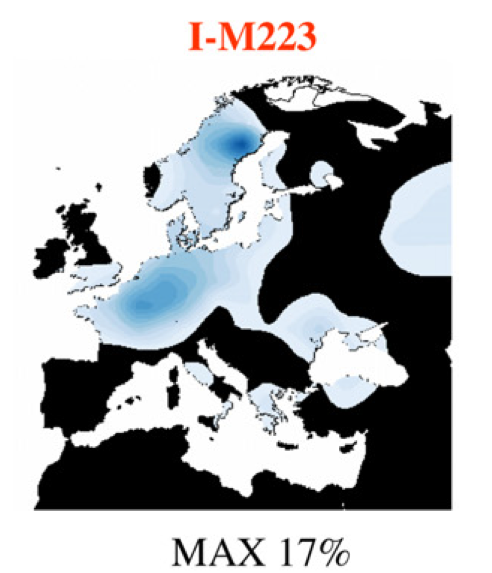Chiaronia et al., 2009 presented a map of M223, too.
Balanovsky et al. 2008 tested for the SNP M223 and found it in several individuals from Russia.
Vologda (2/121=1.7%)
Unzha (2/52=3.8%)
Kashin (3/73=4.1%)
Livni (1/110=0.9%)
Belgorod (1/143=0.7%)
Kuban Cossacs (2/90=2.2%)
I am still collecting I2b1 data, I will update this post later today.
Edit:
In older publications M223 is also called I1c.
M223 frequency in Europe (From Table 1 in Rootsi et al., 2004):
Portuguese (5/303=1.6%)
Madeiran (Portugal) (2/132=1.5%)
Azorean (Portugal) (2/121=1.6%)
Cape Verde Islanders (1/201=0.5%)
Italian (northern Italy) (2/194=1.0%)
Italian (central Italy) (6/196=3.0%)
Italian (Calabria) (2/148=1.4%)
Italian (Albanese origin) (3/78=3.8%)
Italian (Sardinia) (2/142=1.4%)
French (Southern France) (1/38=5.3%)
French (Low Normandy) (1/42=4.8%)
French (Lyon, Poitier) (1/99=1.0%)
German (2/16=12.5%)
Dutch (3/30=10%)
Swedish (South Sweden) (6/168=3.6)
Norwegian (1/72=1.4%)
Estonian (1/210=0.5%)
Latvian (1/86=1.2%)
Polish (2/191=1.0%)
Czech and Slovak (2/198=1.0%)
Hungarian (2/162=1.2%)
Byelorussian (1/147=0.7%)
Ukrainian (3/585=0.5%)
Russian (Kostroma region) (2/53=3.7%)
Russian (Belgorod region) (1/144=0.7%)
Russian (Cossacks) (2/97=2.0%)
Russian (Adygea) (1/78=1.3%)
Mordvin (4/83=4.8%)
Chuvashes (2/80=2.5%)
Slovenian (1/55=1.8%)
Croat (mainland) (1/189=0.5%)
Albanian (4/106=3.8%)
Romanian (7/361=1.9%)
Moldavian (2/60=3.3%)
Gagauz (Moldova) (4/79=5.1%)
Greek (4/261=1.5%)
Turkey (5/741=0.7%)
Lebanese (1/66=1.5%)
The map based on Rootsi et al., 2004:
The number of tested Germans and Dutch is actually very low in this paper (N=16 and N=30, respectively), so the frequency in this region might be off.
The network of haplogroup I was obtained by using the biallelic markers and six STR loci (DYS19, DYS388, DYS390, DYS391, DYS392, and DYS393) in 533 Hg I chromosomes from 34 populations:
Interestingly, the Near Eastern STR haplotypes of I1c (M223) and I1a (M253) are both in the 'core' of their haplogroups, respectively.
It is also interesting to note that M223 is the one of the oldest SNPs in haplogroup I.





Intresting stuff.
ReplyDeleteIts also found in Iran isn't it? A Neolithic diffusion from Anatolia into iran is a possibility imo.
Hey.
ReplyDeleteMy family is I2a2a D Isles, Fife come from Scotland, but we have 150 years of living in Costa Rica, Central America and this is the facebook for my family that opened:
http://www.facebook.com/familiaphillipsdecostarica
All of my country are Phillips of Haplogruop I2a2a.
This link is the genealogy of my family research for 25 years:
http://historiadelosphillipsdecostarica.blogspot.com/
Greetings.
Richard Phillips.
Hello Richard, I think you are talking about I2a1b1* (old I2a2a-M423). This is a different branch, not M-223.
ReplyDeleteMy brother submitted a sample for Y DNA analysis, and we learned that our direct paternal line is I2B1. Family legend says that our immigrant ancestor came from Germany. An Ohio county history gives a short biography of our 4th great grandfather and says that his family originated in Holland. I'm offering this as anecdotal proof of your research.
ReplyDeleteHi Genevieve, I have a feeling that we might be distantly related? My brother has the same haplogroup, you wouldn't be talking about the Waltz family by any chance? I am on 23andme and GedMatch, maybe we could share info? -Heather Goulooze
DeleteI believe that I2a2a comes from the Vandals and/or Goths, which are actually Slavic peoples that come in around Poland. They migrated to Spain then through North Africa, then they dispersed through Southern Europe. They probably mixed with arabs along the way.
ReplyDelete